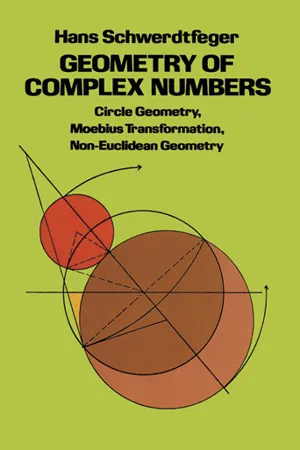
- 224 pages
- English
- ePUB (mobile friendly)
- Available on iOS & Android
Geometry of Complex Numbers
About this book
"This book should be in every library, and every expert in classical function theory should be familiar with this material. The author has performed a distinct service by making this material so conveniently accessible in a single book." — Mathematical Review
Since its initial publication in 1962, Professor Schwerdtfeger's illuminating book has been widely praised for generating a deeper understanding of the geometrical theory of analytic functions as well as of the connections between different branches of geometry. Its focus lies in the intersection of geometry, analysis, and algebra, with the exposition generally taking place on a moderately advanced level. Much emphasis, however, has been given to the careful exposition of details and to the development of an adequate algebraic technique.
In three broad chapters, the author clearly and elegantly approaches his subject. The first chapter, Analytic Geometry of Circles, treats such topics as representation of circles by Hermitian matrices, inversion, stereographic projection, and the cross ratio. The second chapter considers in depth the Moebius transformation: its elementary properties, real one-dimensional projectivities, similarity and classification of various kinds, anti-homographies, iteration, and geometrical characterization. The final chapter, Two-Dimensional Non-Euclidean Geometries, discusses subgroups of Moebius transformations, the geometry of a transformation group, hyperbolic geometry, and spherical and elliptic geometry. For this Dover edition, Professor Schwerdtfeger has added four new appendices and a supplementary bibliography.
Advanced undergraduates who possess a working knowledge of the algebra of complex numbers and of the elements of analytical geometry and linear algebra will greatly profit from reading this book. It will also prove a stimulating and thought-provoking book to mathematics professors and teachers.
Frequently asked questions
- Essential is ideal for learners and professionals who enjoy exploring a wide range of subjects. Access the Essential Library with 800,000+ trusted titles and best-sellers across business, personal growth, and the humanities. Includes unlimited reading time and Standard Read Aloud voice.
- Complete: Perfect for advanced learners and researchers needing full, unrestricted access. Unlock 1.4M+ books across hundreds of subjects, including academic and specialized titles. The Complete Plan also includes advanced features like Premium Read Aloud and Research Assistant.
Please note we cannot support devices running on iOS 13 and Android 7 or earlier. Learn more about using the app.
Information














Table of contents
- Cover
- Title Page
- Copyright Page
- Contents
- Dedication
- Preface
- Introduction
- Chapter I. Analytic Geometry Of Circles
- Chapter II. The Moebius Transformation
- Chapter III. Two-Dimensional Non-Euclidean Geometries
- Appendices
- Bibliography
- Supplementary Bibliography
- Index